Stinger Hook Or Trailer Hook?
A Rose By Any Other Name
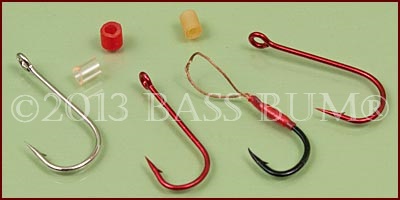
Bass strike short all the time when they're not in an aggressive mood. Stinger hooks can help solve that problem and get you catch more bass.
Simply put, it's a second hook that augments the catch capability of your lure.
Walleye fishermen have used them for years to help avoid walleye from stealing live minnows from the hook by merely grabbing its tail.
In bass fishing they are used on spinnerbaits, swimbaits, spoons and jigs. Bass fishermen usually use "looped stingers" or traditional "trailers".
Looped Stinger Hook
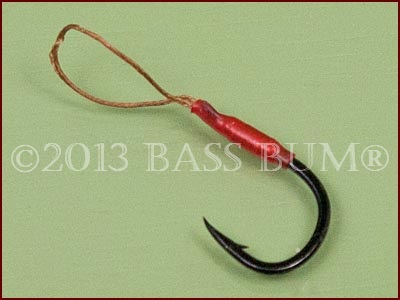
The stinger hook at right is from Gamakatsu (called G-Stinger) and is the one I use, though other companies have similar stinger hooks. The point on this one is sticky sharp out of the package. It's a short shank hook that is forged, which means it is very strong. Attached to the hook is a piece of 30lb braided line. The loop connection at the hook is covered with shrink tubing for protection from wear.
I use it on spinnerbaits, buzzbaits, soft jerkbaits and swimbaits, though I think it was originally developed for use on vertical jigs, where I also use it. Some anglers use it on other hard body topwater lures. I've never done so so can't really speak to the effectiveness of this. However, I'll give it a try and report on my success.
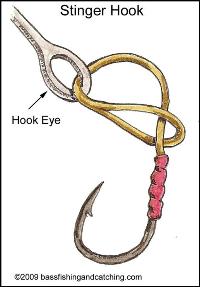
How is this hook attached to a lure? Easy. Just run the loop through the eye of a lure or hook, loop it back over the stinger hook, pull it tight and "wa la", you're done. You can let it hang free, though this makes it prone to snagging, or you can choose to embed it into the bait.

Not Your Average Fluke!
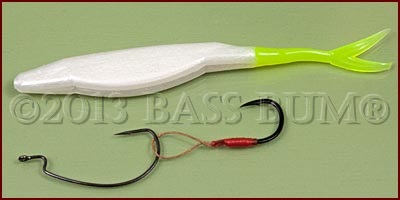
Stinger hooks are also effective at preventing short strikes on soft jerkbaits. Just assemble it as shown right. Rig your EWG hook to your fluke then attach the stinger to the hook by passing the hook through the loop and pulling tight.
You'll want to pass the hook through the loop as shown in the illustration above of the hook being attached through the hook eye.
Trailer Hooks for Buzzbaits and Spinnerbaits
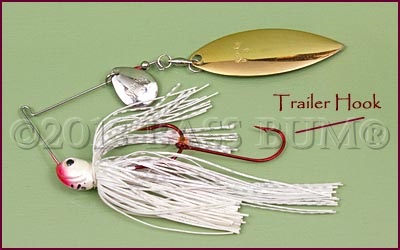
Trailer hooks are usually heavy, strong hooks with over sized rings, which facilitate slipping the hook over the host hook's point and barb. There are long and short versions of trailer hooks. The long style will extend beyond the skirt on spinnerbaits and buzzbaits and some anglers feel this makes them visible to bass. Short models hide within the skirt. There is also a tendency for the longer ones to snag. Which is used is really a matter of personal preference.
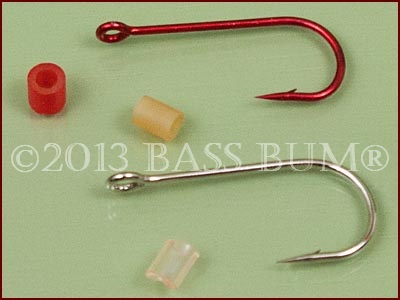
Proper rigging trailer hooks on spinnerbaits and buzzbaits is very important. There are two ways this can be done. Anglers argue about which is best. I've done both and don't really see any issue. Nevertheless, here are the two methods for attaching a trailer hook to a spinnerbait or buzzbait.
- Slide the trailer hook on the lure's host hook first (the large ring provides for this) and then add a piece of plastic or surgical tubing over the lure's hook point sliding it down just past the bend. This serves as a stop to prevent the trailer from coming off the host hook. This technique is best, it is argued, because it allows for free movement of the hook.
- Place a piece of surgical tubing over the eye of the trailer then push it on the point of the host hook. You will notice the trailer hook extends rigidly out from the bend of the host hook. It will not slide up and down the shank of the host hook. Some anglers insist that you should not put the tubing over the trailer hook's eye and then push it on the lure hook's point. This will, in their opinion, inhibit free movement of the hook and reduce its effectiveness.
However you choose to do it, make sure the bend in the trailer hook is "up or down" matching the lure's hook!

"Cluck Up" You Spinnerbaits and Buzzbaits
Try adding a "dressed" treble hook as a trailer hook to a spinnerbait or buzzbait. It will hook those bass that swat at these topwater lures. Here are a couple of arrangements I've tried with success.
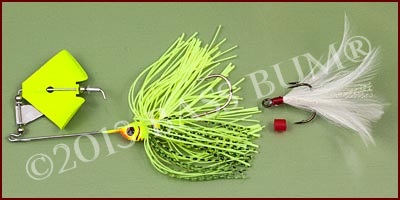
The photo above utilizes a standard dressed Gamakatsu treble hook, size 4 or 6, slid over the lures hook and secured with plastic tubing.
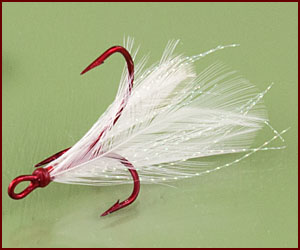
The right photo shows a SURESET® treble hook. The position of the SURESET® hook's eye is designed to cause the large point to always be "up". So, unless you use a split ring connected to the hook and slid over the buzzbait's hook point, the large point of the treble hook will extend off to the side.
By using a split ring you can place it so it is either "up" or "down". To finish I place a piece of plastic tubing to secure it.
Return to Fish Hooks Fron Stinger Hook
